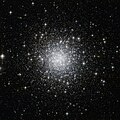Globular cluster

A globular cluster is a group of stars of a similar age which orbits the central bulge of a galaxy. Gravity holds clusters together and gives them their spherical shape. Towards the centre of such clusters, there are many stars in a relatively small space.
Globular clusters occur in the halo of a galaxy and in its disk. Those in the halo contain many more stars and are much older than the less dense open clusters in the disk. Globular clusters are fairly common: there are about 150 to 158 known globular clusters in the Milky Way.[2][3][4] Large galaxies can have more: Andromeda may have as many as 500.[5]
Some giant elliptical galaxies, particularly those at the centres of galaxy clusters, such as M87,[6] have as many as 10,000 globular clusters. These globular clusters orbit the galaxy out to huge distances, 40 kiloparsecs (approximately 131,000 light-years) or more.[7]
Every galaxy of sufficient mass in the Local Group has its group of globular clusters, and almost every large galaxy surveyed has a system of globular clusters.[8] The Sagittarius Dwarf and Canis Major Dwarf galaxies appear to be in the process of donating their associated globular clusters (such as Palomar 12) to the Milky Way.[9] This demonstrates how many of this galaxy's globular clusters might have been acquired in the past.
Observation history
| Cluster name | Discovered by | Year |
|---|---|---|
| M22 | Abraham Ihle | 1665 |
| ω Cen | Edmond Halley | 1677 |
| M5 | Gottfried Kirch | 1702 |
| M13 | Edmond Halley | 1714 |
| M71 | Philippe Loys de Chéseaux | 1745 |
| M4 | Philippe Loys de Chéseaux | 1746 |
| M15 | Jean-Dominique Maraldi | 1746 |
| M2 | Jean-Dominique Maraldi | 1746 |
The first globular cluster discovered was M22 in 1665,[10] but individual stars in a globular cluster were not seen until Charles Messier observed M4.[11] The first eight globular clusters discovered are shown in the table. The M before a number refers to the catalogue of Charles Messier, while NGC is from the New General Catalogue.
William Herschel began a survey program in 1782 using larger telescopes and was able to resolve the stars in all 33 of the known globular clusters. In addition he found 37 additional clusters. In Herschel's 1789 catalog of deep sky objects, his second such, he became the first to use the name globular cluster as their description.[11]
The number of globular clusters discovered continued to increase, reaching 83 in 1915, 93 in 1930 and 97 by 1947. A total of 152 globular clusters have now been found in the Milky Way galaxy, out of probably 180 ± 20.[4] The additional, undiscovered globular clusters are believed to be hidden behind the gas and dust of the Milky Way.
Globular Cluster Media
NGC 7006 is a highly concentrated, Class I globular cluster.
NGC 2808 contains three distinct generations of stars.NASA image
Globular star cluster Messier 54
Djorgovski 1's stars contain hydrogen and helium, but not much else. In astronomical terms they are metal-poor.
Messier 53 contains an unusually large number of a type of star called blue stragglers.
Globular cluster M15 may have an intermediate-mass black hole at its core, but this claim is contested.
Simulation of stellar motions in Messier 4, where astronomers suspect that an intermediate-mass black hole could be present. If confirmed, the black hole would be in the center of the cluster, and would have a sphere of influence (black hole) limited by the red circle.
H–R diagram for the globular cluster M3. There is a characteristic "knee" in the curve at magnitude 19 where stars begin entering the giant stage of their evolutionary path, the main-sequence turnoff.
NGC 411 is classified as an open cluster.
References
- ↑ The Hubble Heritage team (1999-07-01). "Hubble images a swarm of ancient stars". HubbleSite News Desk (Space Telescope Science Institute). http://hubblesite.org/newscenter/newsdesk/archive/releases/1999/26/. Retrieved 2006-05-26.
- ↑ Harris, William E. (February 2003). "Catalog of parameters for Milky Way globular clusters: the database". Retrieved 2009-12-23.
- ↑ Frommert, Hartmut (2007). "Milky Way globular clusters". SEDS. Archived from the original on 2006-01-18. Retrieved 2008-02-26.
- ↑ 4.0 4.1 Ashman, Keith M.; Zepf, Stephen E. (1992). "The formation of globular clusters in merging and interacting galaxies". Astrophysical Journal, Part 1. 384: 50–61. Bibcode:1992ApJ...384...50A. doi:10.1086/170850.
{{cite journal}}: CS1 maint: multiple names: authors list (link) - ↑ Barmby P.; Huchra J.P. (2001). "M31 Globular clusters in the Hubble Space Telescope Archive: I. Cluster detection and completeness". The Astronomical Journal. 122 (5): 2458–2468. arXiv:astro-ph/0107401. Bibcode:2001AJ....122.2458B. doi:10.1086/323457. S2CID 117895577.
{{cite journal}}: CS1 maint: multiple names: authors list (link) [1] - ↑ McLaughlin, Dean E; Harris, William E. & Hanes, David A. (1994). "The spatial structure of the M87 globular cluster system". Astrophysical Journal. 422 (2): 486–507. Bibcode:1994ApJ...422..486M. doi:10.1086/173744.
{{cite journal}}: CS1 maint: multiple names: authors list (link) - ↑ Dauphole B.; et al. (1996). "The kinematics of globular clusters, apocentric distances and a halo metallicity gradient". Astronomy and Astrophysics. 313: 119–128. Bibcode:1996A&A...313..119D.
- ↑ Harris, William E. (1991). "Globular cluster systems in galaxies beyond the Local Group". Annual Review of Astronomy and Astrophysics. 29 (1): 543–579. Bibcode:1991ARA&A..29..543H. doi:10.1146/annurev.aa.29.090191.002551.
- ↑ Dinescu D.I; et al. (2000). "The absolute proper motion of Palomar 12: a case for tidal capture from the Sagittarius dwarf spheroidal galaxy". The Astronomical Journal. 120 (4): 1892–1905. arXiv:astro-ph/0006314. Bibcode:2000AJ....120.1892D. doi:10.1086/301552. S2CID 118898193.
- ↑ Sharp N.A. "M22, NGC6656". REU program/NOAO/AURA/NSF. Archived from the original on 2014-10-17. Retrieved 2006-08-16.
- ↑ 11.0 11.1 Boyd, Richard N. (2008). An introduction to nuclear astrophysics. University of Chicago Press. p. 376. ISBN 978-0-226-06971-5.








